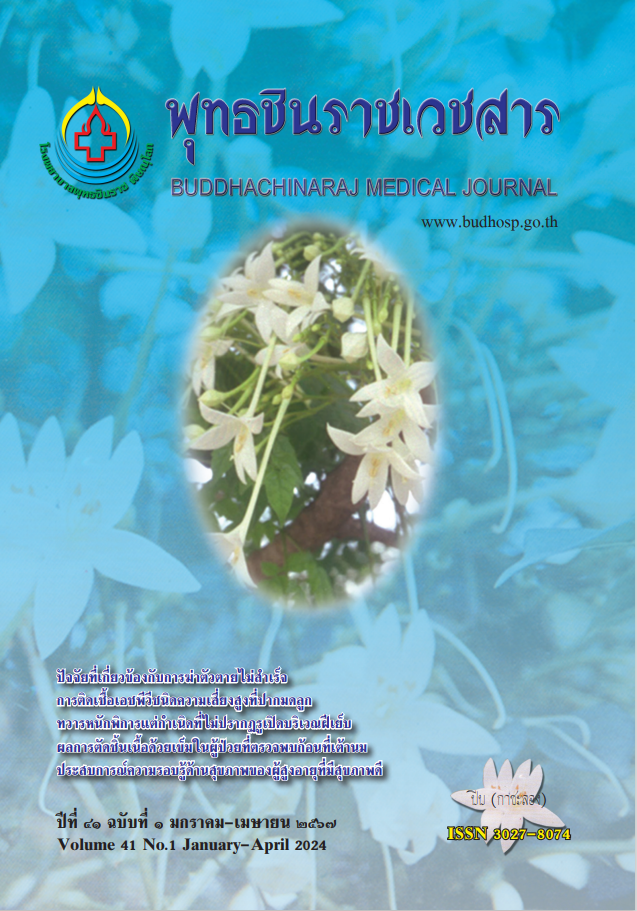การเกิดภาวะไข้ร่วมกับเม็ดเลือดขาวชนิดนิวโทรฟิลต่ำของผู้ป่วยมะเร็งต่อมน้ำเหลืองนอนฮอดจ์กินชนิดบีเซลล์ที่ได้รับเคมีบำบัดครั้งแรก
อุบัติการณ์และปัจจัยเสี่ยงต่อการเกิดภาวะไข้ร่วมกับเม็ดเลือดขาวชนิดนิวโทรฟิลต่ำของผู้ป่วยมะเร็งต่อมน้ำเหลืองนอนฮอดจ์กินชนิดบีเซลล์ที่ได้รับเคมีบำบัดครั้งแรกเป็นสูตรที่ประกอบด้วย CHOP
คำสำคัญ:
ภาวะไข้ร่วมกับเม็ดเลือดขาวชนิดนิวโทรฟิลต่ำ, ปัจจัยเสี่ยง, มะเร็งต่อมน้ำเหลืองนอนฮอดจ์บทคัดย่อ
ภาวะไข้ร่วมกับเม็ดเลือดขาวชนิดนิวโทรฟิลต่ำเป็นภาวะแทรกซ้อนสำคัญของการรักษามะเร็งต่อมน้ำเหลืองด้วยเคมีบำบัด งานวิจัยนี้ประเมินอุบัติการณ์และปัจจัยเสี่ยงต่อการเกิดภาวะดังกล่าว รวมถึงเชื้อก่อโรคที่พบ อัตราการนอนโรงพยาบาล และอัตราการเสียชีวิต โดยศึกษาข้อมูลย้อนหลังในผู้ป่วยมะเร็งต่อมน้ำเหลืองนอนฮอดจ์กินชนิดบีเซลล์ที่ได้รับเคมีบำบัดครั้งแรกเป็นสูตรที่ประกอบด้วย CHOP ในโรงพยาบาลพุทธชินราช พิษณุโลก ระหว่างวันที่ 1 มกราคม พ.ศ. 2558 ถึงวันที่ 31 ธันวาคม พ.ศ. 2562 มีผู้ป่วยเข้าร่วม 300 คน พบภาวะไข้ร่วมกับเม็ดเลือดขาวชนิดนิวโทรฟิลต่ำ 114 คน (ร้อยละ 38) โดยปัจจัยที่เกี่ยวข้องกับการเกิดภาวะไข้ฯ อย่างมีนัยสำคัญทางสถิติจากการศึกษาแบบพหุตัวแปร ได้แก่ อายุที่มากขึ้น (adj OR 1.03, 95%CI 1.01-1.05, p = 0.005), โรคร่วมเป็นโรคเบาหวาน (adj OR 2.48, 95%CI 1.06-5.79, p = 0.035), โรคไตวายเรื้อรัง (adj OR 25.52, 95%CI 2.26-288.48, p = 0.009), ค่า ANC เริ่มต้นที่ต่ำกว่า (adj OR 1.02, 95%CI 1.01-1.02, p = 0.002), ค่า LDH ที่สูงกว่า (adj OR 1.02, 95%CI 1.01-1.02, p < 0.001), การได้รับ CNS prophylaxis (adj OR 3.93, 95%CI 1.58-9.75, p = 0.003) พบอัตราการนอนโรงพยาบาลร้อยละ 98.2 อัตราการเสียชีวิตใน 30 วันร้อยละ 12.3 และเชื้อก่อโรคที่พบบ่อย ได้แก่ แบคทีเรียชนิดแกรมลบ สรุปว่าปัจจัยเสี่ยงต่อการเกิดภาวะไข้ฯ ได้แก่ อายุที่มากขึ้น มีโรคร่วมเป็นโรคเบาหวานและโรคไตวายเรื้อรัง
เอกสารอ้างอิง
The Global Cancer Observatory (GCO). World Global Cancer Observatory [Internet]. 2020 [cited 2022 Apr 17]. Available from: https://gco.iarc.fr/today/data/factsheets/ populations/900-world-fact-sheets.pdf
The Global Cancer Observatory (GCO). Thailand Global Cancer Observatory [Internet]. 2020 [cited 2022 Apr 17]. Available from: https://gco.iarc.fr/today/data/factsheets/ populations/764-thailand-fact-sheets.pdf
Kim YR, Kim SJ, Park Y, Oh SY, Yun HJ, Mun YC, et al, Korean Society of Hematology Lymphoma Working Party. Risk factors for neutropenic fever in non-Hodgkin’s lymphoma patients with primary granulocyte colony-stimulating factor prophylaxis. Korean J Intern Med 2021;36(5):1181. doi: 10.3904/kjim.2020.206
Yokoyama M, Kusano Y, Nishihara A. Incidence and risk factors for febrile neutropenia in Japanese patients with non-Hodgkin B-cell lymphoma receiving R-CHOP: 2-year experience in a single center (STOP FN in NHL 2) Support Care Cancer 2019;28(2):571-9.
Yokoyama M, Kusano Y, Takahashi A, Inoue N. Incidence and risk factors of febrile neutropenia on patients with non-Hodgkin B-cell lymphoma receiving R-CHOP in a single center in Japan. Support Care Cancer 2017;25(11):3313-20.
Puchitsathian R. High incidence of febrile neutropenia in non-Hodgkin lymphoma patients receiving CHOP chemotherapy despite G-CSF prophylaxis. J Hematol Transfus Med (2017);27(1):45-56.
Sirichantharawat C, Pathnapalagonskoon R. Risk factors of febrile neutropenia in patients with lymphoma receiving chemotherapy. HSCR 2021;36(1):74-83.
Parodi RL, Lagrutta M, Tortolo M, Navall E, Rodríguez MS, Sasia GF, et al. A multicenter prospective study of 515 febrile neutropenia episodes in Argentina during a 5-year period. Plos one 2019;14(10):e0224299. doi: 10.1371/journal.pone.0224299 eCollection 2019.
Al-Tawfiq JA, Hinedi K, Khairallah H, Saadeh B, Abbasi S, Noureen M, et al. Epidemiology and source of infection in patients with febrile neutropenia: A ten-year longitudinal study. J Infect Public Health 2019;12(3):364-6.
Auesomwang C, Suwannawiboon B, Chayakulkeeree M. Changes in etiologic microorganisms in Thai patients with chemotherapy-induced neutropenia and fever. J Med Assoc Thai 2018;101(2):173-80.
Freifeld AG, Bow EJ, Sepkowitz KA, Boeckh MJ, Ito JI, Mullen CA, et al. Clinical practice guideline for the use of antimicrobial agents in neutropenic patients with cancer: 2010 update by the Infectious Diseases Society of America. CID 2011;52(4):e56-93. doi: 10.1093/cid/ciq147
Tenny S, Boktor SW. Incidence. [updated 2023 Apr 10, cited 2022 Apr 17]. In: StatPearls [Internet]. Treasure Island (FL): StatPearls Publishing; 2024 Jan [cited 2024 Apr 29]. Available from: https://www.ncbi.nlm.nih.gov/books/NBK430746/
The Thai Society of Hematology. Guideline for Diagnosis and Treatment for Lymphoma [Internet]. 2022 [cited 2022 Apr 17]. Available from: https://www.tsh.or.th/file_upload/files/Lymphoma%20Guideline%202022.pdf
Rampello E, Fricia T, Malaguarnera M. The management of tumor lysis syndrome. Nat Clin Prac Oncol 2006;3(8):438-47.
Choi YW, Jeong SH, Ahn MS, Lee HW, Kang SY, Choi JH, et al. Patterns of neutropenia and risk factors for febrile neutropenia of diffuse large B-cell lymphoma patients treated with Rituximab-CHOP. J Korean Med Sci 2014;29(11):1493-500.
Limvorapitak W, Khawcharoenporn T. Incidence, risk factors, and outcomes of febrile neutropenia in Thai hematologic malignancy patients receiving chemotherapy: A 6-year retrospective cohort study. Asian Pac J Cancer Prev 2015;16(14):5945-50.
Aapro MS, Bohlius J, Cameron DA, Lago LD. 2010 update of EORTC guidelines for the use of granulocyte-colony stimulating factor to reduce the incidence of chemotherapy-induced febrile neutropenia in adult patients with lymphoproliferative disorders and solid tumours. Eur J Cancer 2011;47(1):8-32.
Weerasubpong B, Makruasi N, Linasmita P, Rattanamongkolgul S. Factors associated with survival outcomes of febrile neutropenia in hematologic malignancy patients. J Med Assoc Thai 2016;99(Suppl 8):S53-62.
ดาวน์โหลด
เผยแพร่แล้ว
ฉบับ
ประเภทบทความ
สัญญาอนุญาต
ลิขสิทธิ์ (c) 2024 ``โรงพยาบาลพุทธชินราช พิษณุโลก

อนุญาตภายใต้เงื่อนไข Creative Commons Attribution-NonCommercial-NoDerivatives 4.0 International License.






